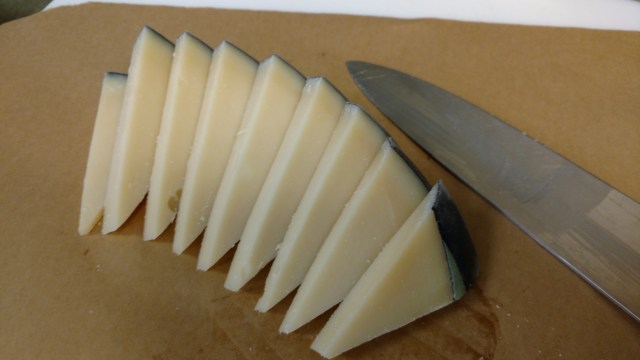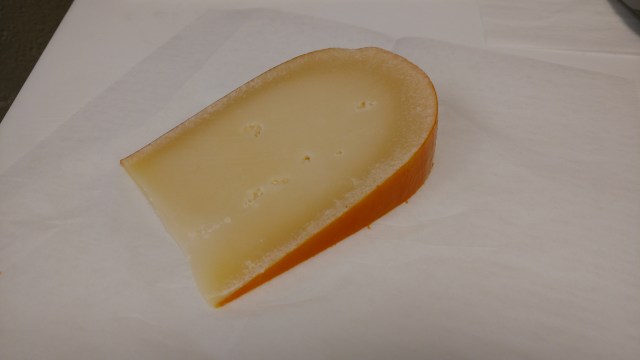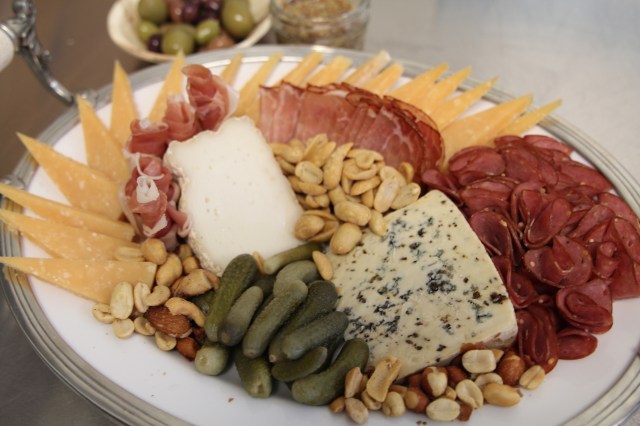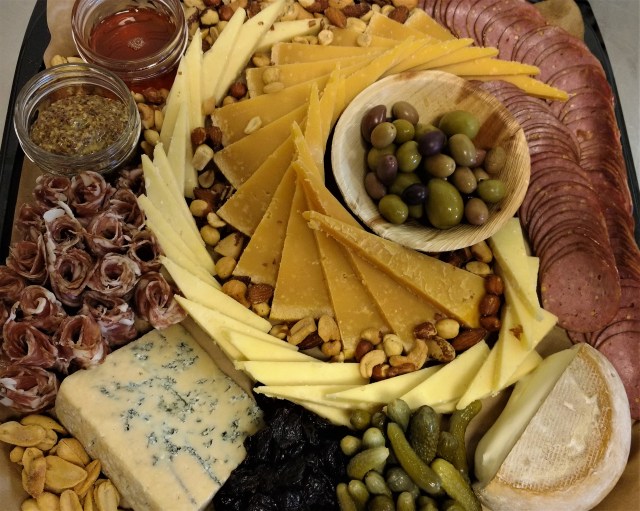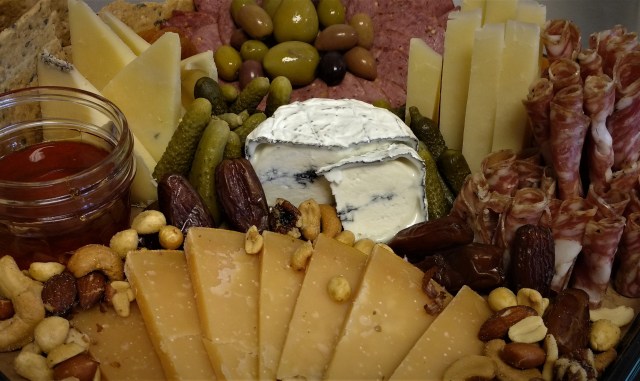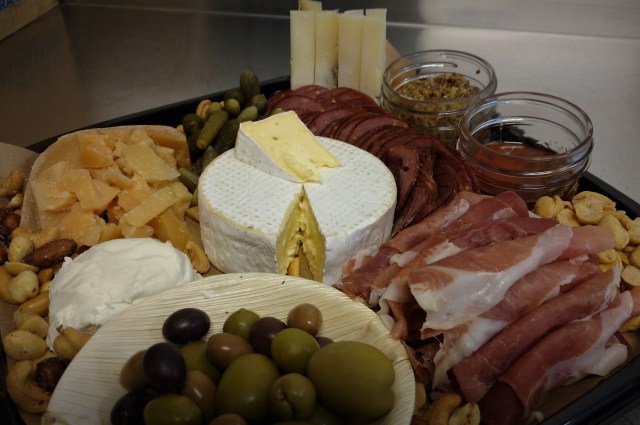There’s actually a very simple test that answers this question without fail: try a little bite of the rind in question. If you like it, keep eating it. If you don’t, don’t.
Nooooo, Mark! I’m at a party and there’s cheese and I don’t wanna look stupid biting into rinds I’m not supposed to eat and avoiding rinds I should be eating! SEND HELP NOW!
Ok, ok, ok, I hear you. I stand behind my original answer, but let’s address which rinds are typically intended to be eaten and which are not.
There are many kinds of cheese rinds, and they serve a variety of purposes. They come in so many textures and colors that it can be hard to sort out what’s what. Let’s start with one that’s easy to identify and offers a very easy answer to the question of whether it should be eaten or not.
WAXED RIND
(Short answer: they’re pretty, but not tasty—don’t eat the wax.)
Waxed rinds are easy to spot because the rinds don’t look like cheese. They look like wax. They feel like wax. They might be a single, bold color—often red or black. Think of those little red Babybel cheeses or a big hunky wedge of red wax gouda or a Manchego with a dark tan or gray wax rind. Some cheddars are aged in wax as well. Some will have artwork printed on them—think of the iconic Midnight Moon, a goat gouda from Cypress Grove. Some have a thin layer of paper glued on to the wax (or even between two layers of wax), typically for artistic adornment and to display information about the cheese. One of my favorites, Ewephoria, has such a rind.

Waxed rinds are added to protect the cheese both while it ages and as it is transported and displayed for sale. They’re essentially a more old-fashioned way of vac-sealing a cheese, maintaining moisture and blocking out contaminants. The wax imparts no flavor to the cheese. It adds only color and a protective seal, so its value is utilitarian and aesthetic, but not culinary.
Obviously, you don’t want to eat wax. It’s not meant to be eaten. But these rinds are made with food-grade wax, so it’s not like eating some would hurt you—it just wouldn’t taste great. You might find that the cheese tastes different closer to the rind than in the center of the wheel (where more moisture remains), and you’re welcome to develop a preference for one part or the other.
Tangential story time: I once saw a customer pick out a cheese nub (these are just little single-serving cuts of cheese that I sell for under 3 bucks each for the sake of folks who just want a bite or two of some different cheeses) and slam the whole thing in her mouth, rind and all, right in front of me. It was a waxed rind gouda with a fair portion of rind on one end. My eyebrows glued themselves to my hairline in astonishment, but she didn’t seem to care about the wax she was chewing so gleefully. Hey, to each their own.
BLOOMY RIND
(Short answer: eat it, unless you don’t like it.)
These “mold-ripened” cheeses have a puffy, white rind made of mold—typically penicillium camemberti or penicillium candidum. Less often, you’ll see a wrinkly-looking bloomy rind made of geotrichum candidum. These molds are all actively and intentionally developed on the cheese. Sometimes powdered vegetable ash is added to control ripening and neutralize the surface, creating a grayish layer just under the rind. Some will have a more yellowish hue, but usually these rinds are bright white. You’ll find bloomy rinds on soft-ripened classics like Camembert, all varieties of Brie, Bucheron, and a long list of cheeses made in those styles (like Humboldt Fog or Green Hill). The white rinds serve at least three purposes: 1) they look lovely, 2) they help the cheese age and ripen properly, and 3) they taste delicious. We call these rinds bloomy because if you look at them under a microscope, you’ll see a field of what looks like lovely white flowers! Or something like that. Left to their own devices, these molds puff up like cotton candy, but cheesemakers pat them down over and over as they grow to develop a firmer, flatter rind. Under that rind, you’ll find the creamline, where the cheese is ripest and gooiest, and under that layer, in the middle of the wheel, is a more firm, caky layer.

Should you eat these rinds? Yes! Or, at least, they are meant to be eaten. I find them absolutely delicious—mushroomy and earthy, balancing the bright, buttery flavors of the paste. If you like the paste (that is, the cheese underneath the rind) but not the rind, I think you should eat the parts you like and skip the rind. Fair enough. BUT! If you’re enjoying the cheese with other guests, don’t just scoop out the paste onto your plate like a goddang cheese pirate. No, cut your wedge and then eat around the rind or remove it on your own plate so you don’t leave a deflated, rindy mess for the next guest. I suppose avoiding the rind is like cutting off the crust on your pbj sandwich—one kind of hopes you’ll grow out of it but, ultimately, there’s no shame in doing your thing your way and enjoying what you like.

WASHED RIND
(Short answer: there is no short answer.)
This one’s a broad category, also sometimes called bacteria-ripened (as opposed to the mold-ripened bloomies discussed above) or smear-ripened. A washed rind is one that has been carefully developed and manicured by the cheesemaker every day of its aging process using a brine solution. A wide variety of ingredients are added to that solution—beer or other alcoholic beverages are common, and bacterial cultures like brevibacterium linens are typical, not to mention the host of other microorganisms in the environment that compete for territory there. The result is typically a cheese with a meaty flavor and pungent rind (aka, stinky cheese). Each unique wash imparts equally unique flavors to the cheese. These rinds take on a burnt orange hue, sometimes more pink, sometimes more gray or tan, sometimes dappled with multiple colors.

I suppose it’s fair to divide washed rinds into two sub-categories:
1) young, gooey, sticky, soft-ripened stinkers in a smallish format (e.g., Taleggio, Epoisses, Limburger, and Alsatian Muenster—“monastic” cheeses, as they’re sometimes called), and
2) firmer, well-aged Alpine cheeses in a larger format (e.g., Raclette, Comte, Gruyere, and Appenzeller).

Some are room-clearingly stinky, while others are quite mild. Often, the pungence of the rind is not reflected in the taste of the cheese underneath it—such that if you smelled the rind first, you’d be afraid to eat it, but you’d be missing out!
Ok, Mark, fine fine fine, blah blah blah, but do you eat the rind?
The rind of the younger, gooey cheeses is typically meant to be eaten. With the firmer Alpine cheeses, the rind isn’t necessarily meant to be eaten, but it can be. In both cases, try it and discover your preferences. Typically, a thin, delicate rind is meant to be eaten, but a hard, thick rind is not. Me? I sometimes enjoy the rind of the younger cheeses if they’re not too gritty, but I almost never eat the rind on the Alpines. They’re flavorful, but the texture is too tough to be enjoyed, in my opinion. That said, I LOVE the bites closest to the rind, as they’re often the most rich in flavor.
NATURAL RIND
(Short answer: usually yes, but you’ll have to try it to know.)
Natural rinds, also known as wild rinds, are carefully tended to by cheesemakers, but the cultures present on the rind are not actively added. The cheesemaker’s role is more passive, allowing ambient cultures to grow on the cheese (remember, after all—you are at this moment covered in and inhaling microorganisms—it’s really ok). Molds, yeasts, and bacteria all compete with each other for space on the surface, ultimately giving a true sense of terroir to the cheese, since no one but mother nature can fully determine the results, which will vary from one aging cellar to another. The cheesemaker might turn, flip, and brush the cheese regularly while tending to the aging room’s temperature and humidity, but no cultures are added during the aging process. One common example is a cloth-bound cheddar. These are bandaged in cloth and slathered in lard before aging for months or even years. The result is often very colorful and flavorful. Sometimes blue molds sneak into crevices to the chagrin of the cheesemaker, but these are naturally-occurring, tasty, and harmless. Many blue cheeses have a natural rind, as do most farmhouse-style tommes.

But do you eat it? Well, I always try it. Sometimes it’s too tough or gritty or leathery. With other cheeses, it’s so delicious that I don’t want a bite without a little rind in it. When I eat Flory’s Truckle, for example, I adore the bites closest to the rind, but I typically cut off just a few millimeters of rind to avoid that grainy texture. On the other hand, I recently opened a new wheel of Sleeping Beauty from Cascadia Creamery and am in love with the rind, which gives a perfect balance of barnyardy flavor and crunch to the more delicate, buttermilky paste. With blues, I almost always love a bit of the natural rind in my bite—Blue Stilton, Glacier Blue, Caveman Blue, and Bayley Hazen all offer delicious mottled gray rinds with just the right amount of texture. Missing out on the rind, in those cases, means missing out on the full flavor of the cheese.
…
This list isn’t exhaustive. There are other types of rinds. For example, the rind of Parmigiano Reggiano is often called a dry rind, which is a bit of a misnomer considering that it’s created with oils and brines. But it’s easy to know that you shouldn’t eat a Parm rind because, well, you can’t. Not without breaking your teeth.
On the other hand, there are FLAVORED RINDS that are very clearly meant to be eaten. Think of those delicious BellaVitano cheeses from Sartori that are bathed in rosemary or black pepper or merlot. Or think of the popular Drunken Goat cheese from Spain, a crowd-pleaser bathed in wine.
Many of us, at least in the U.S., grew up eating almost exclusively RINDLESS CHEESES. Those don’t really belong in this post, for obvious reasons. I will say this about rindless cheeses: sometimes they do have a sort of pseudo-rind, and that pseudo-rind raises questions. For example, a vac-sealed loaf of aged cheddar will look a little different, a little more crystallized, on the outside edges. Customers have asked me if those ends are okay to eat. Is it moldy? It’s not moldy, but you’ll see more calcium crystallization on the outside edges of a cheddar aged in plastic vac-seal. The crystals are not only ok, but desirable (because crunchy cheddar is RAD). Likewise, rindless smoked cheeses are obviously darker and firmer at the outside edges. In those cases, smoking has created color and dryness around the exterior of the cheese—no worries. If you get a cut from the end of the loaf, it might have a little more smoke flavor, but that’ll be the only difference from any other cut.

Drop me a line if you have questions I haven’t answered here! Just remember: if you’re not sure, TRY IT! I’m unaware of any cheese rinds that are actually dangerous to eat (other than the risk of cracking your teeth on an especially hard rind, but I’m sure you’ll figure that one out before needing an emergency appointment at the dentist). Happy cheesing!








